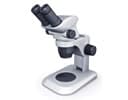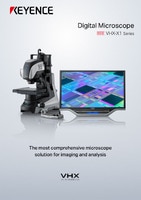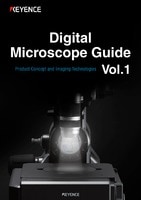Stereoscopic Microscopes
- What is a Stereo Microscope?
- Stereoscopic Microscope Parts and Functions
- Stereo Microscope Applications
- The Merit of VHX Digital Microscope as a Stereoscopic Microscope
What is a Stereo Microscope?

Probably the most general form of an optical microscope. These systems generally provide a user with a lower magnification range than compound microscopes and have longer working distances for imaging larger, three-dimensional targets. Stereo microscopes have two eyepieces to allow for 3D observation and are useful when performing assembly or re-work.
Stereoscopic Microscope Parts and Functions
A stereoscopic binocular microscope generally consists of several components. The stage holds the sample, and light is projected down onto the sample from underneath the lenses. The objective lenses take in the image and magnify it. A focus knob is used to bring the head up and down to provide a clearer picture. The stereo head contains the ocular lenses, which are what the observer looks through to see the image.
Stereo Microscope Applications
As the most common type of optical microscope, stereoscopic microscopes can be found in a wide range of environments and applications. They are used in classrooms, laboratories, and production facilities to observe fine details of multiple types of materials. For example, stereoscopic dissecting microscopes may be used by entomologists to study insects, or by electronics repair professionals while repairing circuit boards.
When considering whether to use a compound microscope vs. a stereoscopic model, it's important to note that the latter enables 3D images. Because they split the same optical path to both eyepieces, compound microscopes only provide a 2D view, albeit at greater magnifications.
Click here to learn more about compound microscopes and their capabilities.
The Merit of VHX Digital Microscope as a Stereoscopic Microscope
1. Full focus - Sharp focus on the entire target
Digital microscopes achieve a large depth-of-field, allowing for accurate observation of a target with a highly uneven surface.
This type of observation helps to greatly reduce the amount of time needed for focus adjustments.
2. Flexibility - View from any angle to never miss another detail
With Variable-angle Observation capability, digital microscopes can achieve observation from multi angles freely, without having to tilt the target.
3. 2D measurements & reporting - Perform advanced measurement and analysis
With just a few clicks, perform a variety of real-time measurements—from distance, radius, and other 2D measurements to automatic area measurements—directly on the screen.
Data can be saved and accessed later for further measurement. Moreover, free communication software makes it possible for anyone to utilise the measurement functions from their own PC.
4. 3D measurement - 3D image stitching and roughness measurement
Digital microscopes can produce fully focused, 3D displays at the push of a button. The three-dimensional measurement function achieves easy observation of the surface shape of a target, and simplifies communication with others.
5. Hand held capability - Observe from all directions
VHX Series Digital Microscopes offer easy, handheld observation. By adjusting the viewing angle of the camera and lens, you will never miss a detail when observing a sample. Furthermore, the time required for inspection can be considerably reduced.
6. 4K monitor - Quickly analyse and discuss an image
Magnified images are displayed onto a large, high-resolution monitor, enabling several people to observe and discuss the images simultaneously on-site. Users can then conduct analyses more efficiently and immediately respond to customer complaints.
7. Optimal lighting - Automatic acquisition of lighting from all directions
By simply pushing the Optimise button, nine different lighting scenarios are displayed.
From there, you can quickly select the image that is ideal for observing your target.
8. Glare removal - Ring removal function suppresses glare on targets
To prevent certain parts of the image being unobservable due to glare, multiple images are acquired while changing the direction of the ring light. This makes it possible to remove unwanted glare on the surface of the target at the press of a button.



